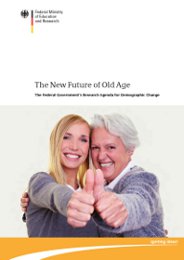Living Safely and Independently
People need protection, safety and a sense of security. A familiar environment and individual place of retreat are most of all important in old age. This calls for living spaces that are functional, economic and ecological, have a healthy indoor climate, and allow for a home decor that complies with individual preferences and needs. We explore how living environments can be designed in a way to ensure that senior residents feel comfortable in their own home for as long as possible. Of equal importance in this respect is the direct residential environment.
Barrier-free living
In old age, many needs change. Buildings, apartments and residential surroundings have to be adapted correspondingly. To ensure the provision of housing for the older generation in the future, the Federal Government examines the current stock of and future demand for apartments that are suitable for seniors. In addition to this we support pilot projects looking into ageappropriate apartment conversion. This also includes funding the development of approaches aimed at the inexpensive removal of existing barriers within buildings. In this process, we pay attention to the quality of the building fabric, the fittings and furnishings in the home environment, the location of the premises, and their accessibility for the provision of care, supplies and services. The focus is on products and services usable by seniors in an unrestricted manner, from the furniture in the living environment via support in everyday activities to getting around safely at home and in one’s residential area.
Self-determined and safe in everyday life
Older people require a safe and stimulating residential environment, also in order to be able to look after their affairs for as long as possible without the practical or legal support of others. Highly developed technical systems offer them the possibility of a long, self-determined life in their own apartment, for example by way of person recognition, as a memory aid, for monitoring activity levels and the state of health, or as a multiplier of physical strength.
Safety is, for example, provided by a sensorcontrolled home emergency call system that informs the rescue services automatically in the case of falling. Stand-up and guiding assistance systems can help seniors navigate their residential environment. The Federal Government funds solutions that allow for largely intuitive handling. The efforts are aimed at providing robust, efficient and learning assistance systems that can be upgraded easily and at low cost, respect the private sphere, and are based on combined sensors, intelligent data analysis and cognitive principles.
Combining technologies and services for a greater quality of life
A home needs to provide a sense of security and provide for the basic requirements. These include cleanliness, the supply of food, and the maintenance of appliances. The domestic chores of seniors such as cleaning the flat are often performed by relatives or service providers. The Federal Government creates new care approaches that combine technical innovations with personal services. To this end, we examine ways in which technical systems support the work of service providers, and what kind of business models are suitable for establishing pertinent products. The combination of technology with human care helps us ensure the social component and a respect for human dignity in the support provided.
Old and young living together – in town and country
Of intergenerational togetherness benefits everybody. The Federal Government therefore develops modern and pioneering residential concepts with various age groups living together. This includes designing inner city areas that are worthwhile for young and old alike. We create the spatial conditions required for older people to continue living in the cities because they can value and rediscover the qualities of urban quarters.
By means of our "Action programme for regional services of general interest", we promote strategies for rural, in parts severely shrinking model regions where the infrastructural challenges of demographic change can be addressed by a forward-thinking and cooperative regional strategy. We want seniors to be able to enjoy a neighbourly "next door" feeling. To this end, we develop concepts for deployment in the actual living environment and in social networks, then facilitated by the help of information and communication technologies. This supports a sense of togetherness among the old and the young by way of social interaction, whilst bringing about a culture of mutual support.


